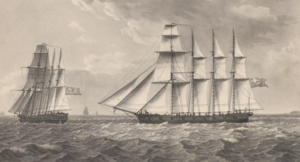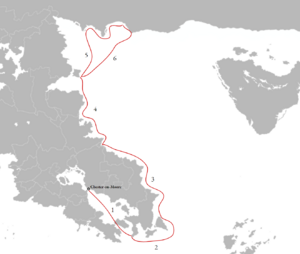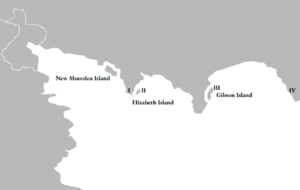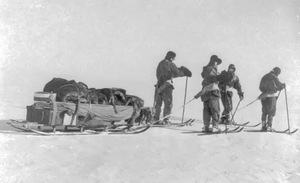Arco Polar Expeditions
The history of Arco Polar Expeditions was a period spanning from 1891-1918 (27 years) during which Ixnay's Arctic was explored by different Arcer explorers. This period was a massive expansion of Arcer naval influence outside of the Malentine and Songun Seas, and much of these travels were sponsored by the Arcerion Naval Service as part of its ongoing efforts to expand its ability to conduct blue-water operations.

During this time period, the Arctic became the focus as it held a great amount of scientific and geographical importance to the Arcer community. As most of Crona was Indigenous, there was few maritime-based opportunities for Acers to explore or venture beyond the South Cronan Peninsula. Therefore, with the initial state-sponsored expedition of 1891, Arcer explorers, navigators, geographers, and officers ventured North through the Odoneru to stake their claim to the frozen expanses of the Arctic Circle. There was 10 major expeditions, although smaller, privately-funded ones also occurred throughout this period but were not as intensely logged or chronicled.
The primary focus of many of the early expeditions were the use of new or novel technologies that expanded the limits of human endurance and physical stamina due to the exceedingly harsh conditions. As well, the Arco climate, mostly plains and warm in nature, did not immediately outfit or set up the explorers for success, and the initial exposure/frostbite casualties of the 1891 and 1893 expeditions reflect this. Although official estimates vary between public and private sources, somewhere between two and three dozen Arcers died during these forays North.
The expeditions also claimed several important achievements for Arcerion, notably being the first nation to have a citizen reach the North Pole, both geographic and magnetic. Previously, nomadic indigenous locals were assumed to have reached it, this was the first time a modern nation state had achieved the accomplishment. Additionally, much of the Arctic coastline was mapped during the first three expeditions, with John Howland's expedition accomplishing not only the survey task, but also the successful mission to Ixnay's North Pole. The expeditions all generated a fair amount of scientific data for the greater Cronan scientific community, much of which became a focal point for inviting Arcer explorers and scientists to Levantia and Sarpedon for conferences and university tours to give lectures and share results with newer explorers.
Origins
Expeditions 1891-1918

Expedition of 1891

This was the first expedition undertaken by Arcerion to the Arctic, leaving in February of 1891 from the Songun port of Chester-on-Moore, the voyage not being entirely completed until late 1892. Led by Walter Hetherington, assisted by the soon-to-be-famous John Howland, it was primarily aimed at an initial survey and geographic mapping of the Arctic peninsulas to the East of Northern Crona, jutting out into the Albion Sea. During this expedition, Hetherington and Howland performed the first full oceanographic and coastal surveys of the Northern Albion Sea. It also discovered two islands Elizabeth Island and Gibson Island. Elizabeth Island, named for Hetherington's first daughter, was discovered during the initial entrance into the Northern reaches of the Albion Sea. Gibson Island was named after a member of the expedition who died after succumbing to cold-weather exposure injuries sustained while exploring the island. During the 1891 expedition, four separate landings and explorations were made by John Howland, the two aforementioned islands, as well as a pair of shore trips onto two separate peninsulas. The expeditions themselves were marked by harsh conditions due to the Arctic weather.

The government sponsored expeditionary research in much of the Cronan Interior for safari-style forays into the continent, however serious maritime navigational exercises and missions had not been accomplished at this point by any Cronan nations. As such, the government contacted the Geography and Survey Department at the Carnish Anglican University in Kurst, Arcerion for a proposal on how they could feasibly explore the Arctic Circle. The head of the department at the time, Walter Hetherington, began recruiting from several sources. Scientific expertise was acquired from the university as well as several architecture and engineering firms in Kinnaird and Kurst. For experience in colder climates and experts on mountaineering and long-distance patrolling, he requested volunteers from Chester Fusliers and Arcerion Easthampton Borderers, a pair of infantry regiments that had particular expertise fighting rebel and guerilla forces in Arcerion's Southeastern mountains. Of these was a former Captain with the Easthampton Borderers, John Howland, By far the most important selection however was the maritime and naval experience, of which Arcerion had limited beyond the Malentine and Songun Seas. Several merchantmen saw profitable opportunities, and career naval officers themselves saw this as a way to stake their claim and make their mark in the annals of the Arcerion Naval Service. As such, dozens of sailors and seamen from Chester-on-Moore and Kurst volunteered for the task. With the personnel assembled and beginning preparations in Chester-on-Moore, the government purchased a pair of sailing ships had to be procured. The Navy had no suitable ships for cold-weather sailing, and as such a pair of ships that had already been commissioned for the Navy were retrofitted during the construction and converted to Arctic exploration vessels. The three-masted Barquentines, named Chester and Emily, would each host a compliment of forty men and the requisite supplies for travel to the Arctic circle. Training and supplies continued to be procured and conducted until February of 1891, when the expedition set off. With an initial stop in Cape Town, the expedition then set off for the Kiravian port of Sirana, following this with a resupply stop in the Republic of New Archduchy. By this point, the journey had been ongoing for several months, with the final pre-Arctic resupply stop made at the Kiravian colony of Xepramonta. Arrival approximately three months after they had set out for the journey, the two ships first sighted the Arctic Coast on the 2nd of May, 1891. With average temperatures at night around -10°C, and during the day around 5°C, the ships were frequently coated with ice. Considering the average temperature in Arcerion at its coldest is roughly the same, many of the more experienced mountaineers found this familiar, but the sailors on the Malentine and Songun Seas had not thus experienced temperatures like this so far. The first foray ashore was made by John Howland on the 6th of May, 1891 and conducted initial surveys and took some rock and soil samples. He was accompanied by three members of the Emily's crew, one of who would later perish due to exposure injuries sustained later in the expedition.
After the Albion Peninsula expedition, which lasted several days, the Chester and Emily both set off to what Hetherington would name Elizabeth Island. On Elizabeth Island, Howland found some signs of human life in the form of rock sculptures and carvings into the rocks on the Northern shore, and the limited cave exploration in the area, and assessed it was from some of the first Indigenous peoples that would have migrated to Crona during the pre-historic era. Upon preparations to leave Elizabeth Island, the Emily struck an iceberg and required repairs, and the crews remained moored off the North Shore for an extra four days while the sailors repaired the damaged hull enough to permit continuing travel.
Setting off at the end of May, the expedition made it around another peninsula and discovered another island. It was here that Nathan Gibson would become the first Arcer to die in the Arctic. John Howland again led an expedition ashore onto the island, but on their second night a snowstorm destroyed much of their camp and supplies. Over a day's travel away from the moored ships, they struggled back across rocky and snow-swept terrain back to the Chester, many of the members suffering from frostbite and hypothermia. Nathan Gibson passed away the next day, which greatly affected morale. Walter Hetherington named the island in his honour, and they conducted a burial on the shore nearby, the gravesite which is still there to this day, constructed of local rocks and with a large cross hewn out of stone and secured with rope. The expedition continued, moving across the sea to the final part of the coastline where they sent another shore party for a longer stint, Howland leading one of two parties, both returning within a week to the coast to be recovered.
The expedition concluded as the ships sailed South, successful in their voyage despite the loss of one of their members. They made the same ports of call upon their return, and upon their return to Arcerion, stopped for brief respite in Chester-on-Moore before a receiving parade in Kurst. The scientific data and navigational charts were methodically studied and used to plan the expedition of 1893, which was again to be led by Walter Hetherington. The impact culturally was incredibly significant. Walter Hentherington and John Howland became household names in Arcerion, and the Carnish Royal Family send a letter of congratulations to the Arcer Parliament congratulating the nation on its expedition, even going so far as extending the invitation to Hetherington to visit Carna to be received by the Crown Regent.
Expedition of 1893
Capitalizing on the success of the 1891 expedition, the Confederate Parliament authorized the raising of a second expedition to take place the following year. Preparations however, were considerably more rushed and this would result in catastrophe. The schooner Emily, still not fully repaired, was not chosen to again participate as one of the ships in the expedition. Chester was to be accompanied a new schooner, Forthright, as well as one of the Naval Service's new frigates, Archer. The Navy was keen on testing the frigate's ability to operate far beyond the Songun as if this was successful it could use it as precedent for additional ships to be constructed. The ships finished preparations not even a full year after the 1891 expedition's return, departing in the summer of 1893.
They followed a similar route, making resupply stops at ports of call in the Cape, Kiravian colonies, and the New Archuchy, but instead of focusing on the Northern Albion Sea, the expedition intended to head farther East, closer to Kiravia, as this stretch of coastline had limited survey and geographical assessments done by even the Kiravians. The main miscalculation here was the poor lack of accountability for the weather's impact. Previosuly, the departure with the turn of Spring in the Northern Hemisphere meant that the temperature was more permissive to the explorers upon their arrival in April/May of 1891. For this expedition however, the summer departure as well as farther distance meant that the October/November arrival brought with it considerable storms and seas which the Forthright struggled in. After a storm in October South of Gibson Island whilst transiting Eastwards, the Forthright lost a mast, its fall crushing two members to death. The loss in propulsion and confusion during the storm required a stop, not too far from the fourth landing in the 1891 expedition, until the mast could be repaired. The hard seas and this delay mean that the expedition arrived at their survey locations in mid-November. With the daily average temperature around -10°C. Only two landings were conducted, one by Hetherington himself for three days, and a second, longer expedition by Howland for nine days. During this time Howland made use of his previous military experience to lead a dozen men the furthest inland at that point that any non-indigenous person had ever went into the Arctic. Using sleds and snowshoes, they made it 46km inland before reaching a halfway point they determined was sufficient and heading back to the Chester.
By this point on the return, the late November temperatures began coating the ships rigging and superstructures with a considerable amount of ice. A lack of de-icing equipment, as well as many of the new volunteers who were not veterans of the 1891 expedition lacking proper winter clothing meant that problems stemming from the initial rush for another successful expedition began to be seen. Disaster struck during another winter storm off the coast of the Albion Peninsula in the last week of November, 1893. Severe icing on the Forthright's rigging had caused her to become overly top heavy. Howland, then leading the land expeditionary contingent on the Archer, as the Emily was undergoing repairs, watched as the Forthright took on a serious list to starboard, and took on water. With waves as high as 25 feet, the ship went under shortly after, with no ability to launch lifeboats, life rafts, etc. The heavy sea state and freezing conditions above and below surface meant that the ability to rescue survivors, if any, was limited. This represented the first serious loss of life on an expedition, the Forthright having 27 souls aboard when she sank.
The return to Arcerion was considerably less enthusiastic as the brave adventurers had lost so many of their own, and the government was incredibly hesitant to now continue funding these expeditions. However the Arco Transpolar Investigatory Commission was setup by the Foreign Office in conjunction with the Naval Service to investigate the sinking of the Forthright, and found that rushed preparations, poorly trained and equipped crew, and a lack of experienced Arctic sailors had led to the demise of the Forthright. However, from this, the government began to work on codifying the requirements for future expeditions should the appetite arise again, and recommended that much more time and effort be invested into future expeditions in order to minimize unnecessary loss of life. Hetherington, in his memoirs, stated that the loss of the Forthright was entirely preventable, and only a mad frenzy to foster another successful expedition had led to the deaths of almost thirty men.
Expedition of 1899
Howland's Expedition
Howland-Rickett Expedition
Expedition of 1911
Expedition of 1914
Towley Expedition
Austin-Taylor Expedition
Expedition of 1918
Deaths and Shipwrecks
Casualties
- Nathan Gibson, 26, Expedition of 1891. Exposure. Buried on Gibson Island.
- Lochlan Robinson, 22, Expedition of 1893. Crushed to death by a falling mast. Buried at Sea.
- Cayden Hall, 29, Expedition of 1893. Crushed to death by a falling mast. Buried at Sea.
Shipwrecks
- Forthright, Schooner. Expedition of 1893. Lost with all hands (27) in the Albion Sea.